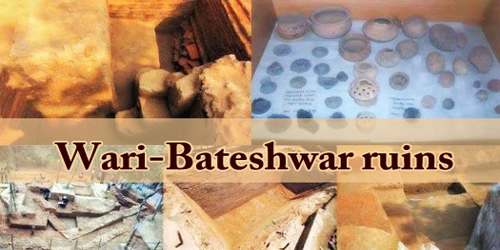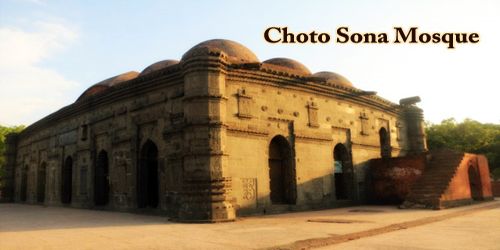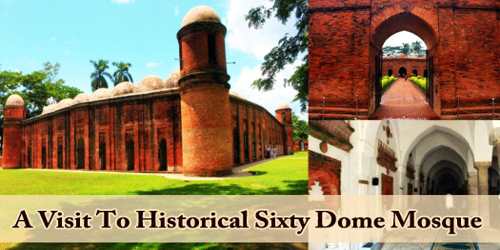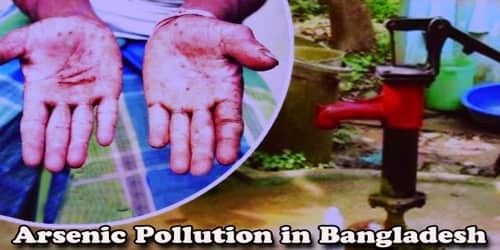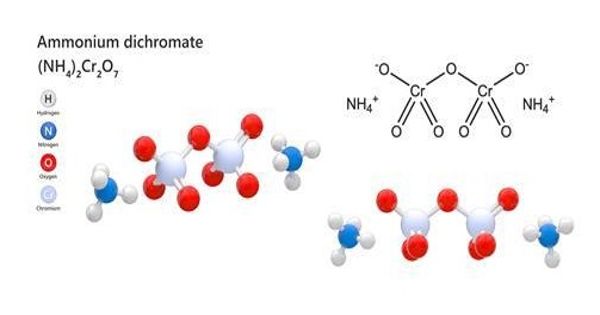The Wari-Bateshwar region (Bengali: উয়ারী-বটেশ্বর Uari-Bôṭeshshor) is an archaeological site in Narsinghdi district of Bangladesh. It is the site of an ancient fort city, based on the artifacts found here the city was alive dating back to about 2000 BC (or more) to 450 BC. The ancient city was discovered near the Wari and Bateshwar villages, around 75 kilometers from Dhaka in the Narshingdi district of Bangladesh, and is considered to be of great archaeological significance. Cultivation of land, digging drains, cutting garbage-pit and red soil for building local traditional mud-house and other household activities of the local people regularly turn the surface upside down which exposes the objects of ancient people in Wari-Bateshwar. In addition, after rainfall, wonderful beads of semi-precious stone and glass, silver punch-marked coins, etc. are rinsed out which results in clear visibility. The 2500-years- more older ruins being unearthed near the old course of the Brahmaputra River are a major archaeological discovery in South Asia. It challenges the earlier notions of early urban civilization in the Bengal.
The site was originally discovered by a local school teacher in 1933, but official excavation by a team from Jahangirnagar University’s Archaeology Department only began in the year 2000. The site is about 70 km north-east from Dhaka situated at Narsingdi’s Belabo Upazila and Shibpur Upazila’s neighboring village Wari and Bateshwar. The tool found in Wari-Bateshwar was given the opinion of the old and the new Stone Age era. But recently, the excavations of Wari-Bateshwar have evidently been discovered in the copper-stone era, due to the finding of houses and black warehouses by digging in the ground, it has been proved that there was human habitation in the copper-stone era. A large number of fossils, wood-built prehistoric base-lets, and hand-axes were found in this region; by looking at the type and shape of the tools, it can be assumed that the first human settlement was developed here during the Neolithic era.
In the 600m x 600m fortified enclosure, there are four mud ramparts. Though most of the parts of the ancient ramparts have been destroyed evidence of 5-7 feet height walls still exist in some places. The ramparts are surrounded by a moat, which, in course of time, silted up and turned into paddy fields. However, the eastern part of the silted moat can easily be visualized. In the west and south-west side of Wari-Bateshwar citadel, there is a 5.8 km long, 20m wide, and 10 m high mud rampart known as Asom Razar Garh. Most probably this was linked to the defensive system of Wari-Bateshwar fort-city which can be considered as the second fortification wall. Nagarjunakonda in India is an example of a double fortified ancient city. Nearly 50 ancient archaeological sites have been found around Wari-Bateshwar, with most of the discoveries being settlements. Some of them are known as Rangartek, Sonartula, Kendua, Morjal, Tongirajar Bari, Mondirbhita, Jankhartek, Tongirtek. The site is a unique significance in the history of Bangladesh. It is located in the old Brahmaputra river basin, was a river port and international commercial center. This is also evidence of the knowledge of developed town planning and the intellectual height of the ancient settlers. In Wari-Bateshwar, two types of silver punch-marked coins have been discovered. One type is Janapada or pre-Mauryan silver punch-marked coins. It is also suspected that it might be the oldest place in the world which have a money-based currency system. Archaeological excavations, such as that of Wari-Bateshwar, open up a window into the past of Bangladesh a fascinating country with an ancient, and sometimes mystifying, history.
